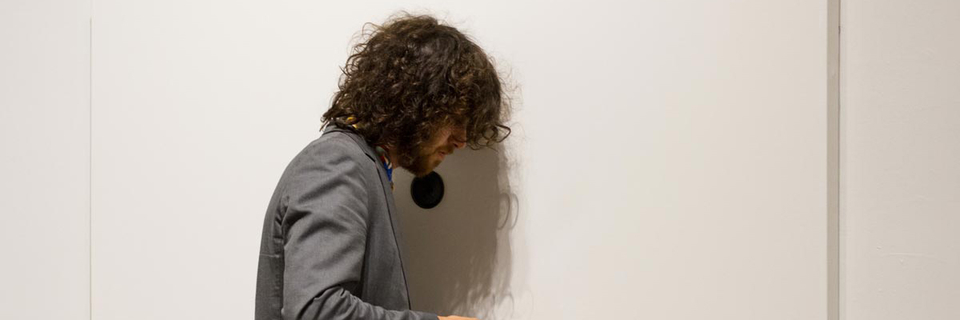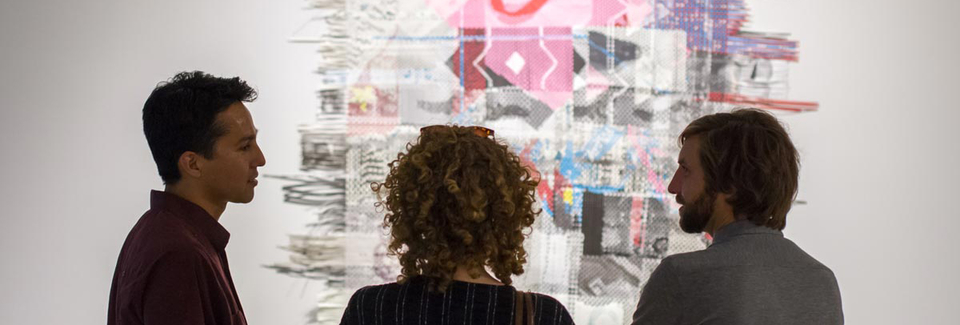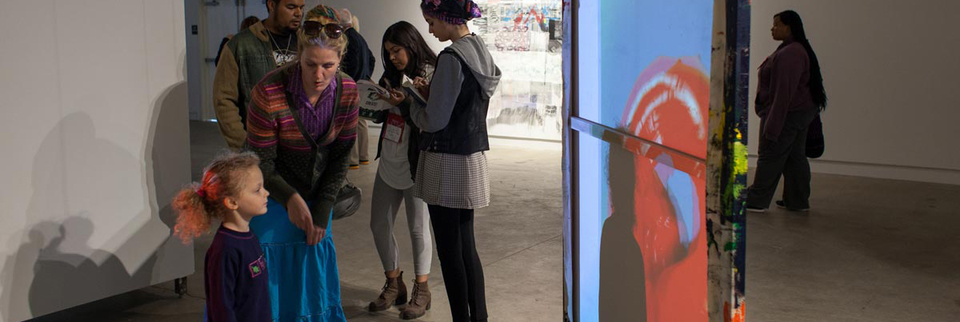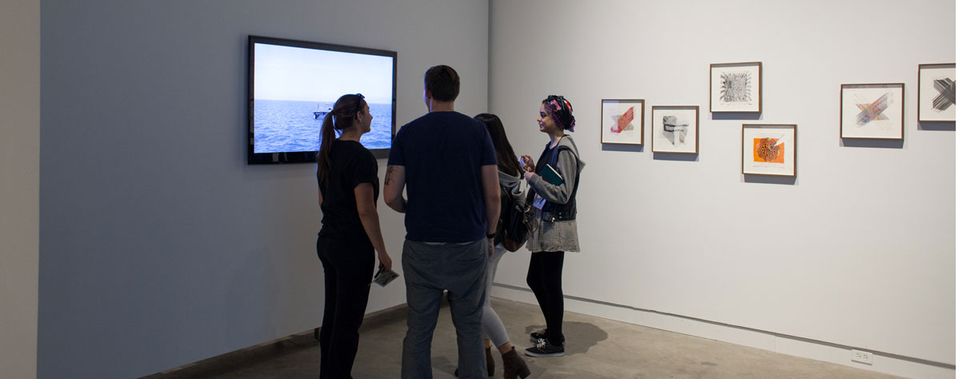Las Cosas Que Pintan
Curated by Aimee Friberg
April 9 – May 17, 2015
reception: Thursday, April 9, 6pm – 9pm
Miguel Arzabe & Juan Sorrentino: Las Cosas Que Pintan / Painting in an Expansive Field
Verge Center for the Arts and CULT | Aimee Friberg Exhibitions are pleased to present Las Cosas que Pintan / Painting in an Expansive Field, a two-person exhibition curated by Aimee Friberg on view from April 9 through May 17 at Verge Center for the Arts in Sacramento. The exhibition features site-specific sound and video installation by Argentinian artist Juan Sorrentino and painting, video, and works on paper by San Francisco-based artist Miguel Arzabe. The works included in Las Cosas que Pintan / Painting in an Expansive Field take as their starting point a field of painting that has been thoroughly examined and expanded by numerous other artists since the advent of Modernism. Rather than attempting to push these boundaries further for the sake of ambition and innovation, Sorrentino and Arzabe investigate the existing terrain of the medium to look for space in which poetic gesture and thoughtful intention combine to reveal truthful contradictions of human experience. The artists’ sensibilities draw from diverse sources––ranging from action and landscape painting to indigenous crafts such as weaving and storytelling––while resisting rigid boundaries and literal translations.
In Sorrentino’s single-channel video Sin Titulos (Untitleds), the camera follows the artist carrying a blank canvas through a field with trees, pausing briefly at certain locations so that the canvas frames branches, grasses, shadows, and other elements of the natural landscape. These moments of arrested motion create temporary “paintings” that last only a few seconds before the canvas moves on, continuing its search for new content, much like the creative brain ceaselessly pursues novel sources of inspiration. As if moving through an infinite “forest of ideas,” the canvas seeks restful moments of sublimity, and then moves on again in search of new revelations.
In the sound installation Cuadros Sonoros (California), Sorrentino explores concepts of visual language, poetic context, and collective imagination. The piece features a grouping of blank canvases of varying sizes, each with a circular perforation containing a small speaker from which emanates the voice of a person describing a particular painting. The size of each canvas is identical to the painting being described. The voice reveals only the physical attributes of each painting, without providing the artist’s name, the painting’s title, or any other contextual information. In Cuadros Sonoros (California), the viewer/listener is invited to use his or her imagination and memory to construct a mental image of the picture, an image that is inevitably informed by subjective experience, so that each individual interpretation of the work becomes deeply personal and utterly unique.
In contrast with Sorrentino’s conceptual exploration of painting, which foregoes the use of the material itself, Miguel Arzabe’s work focuses on the ways in which the physical substance of paint holds meaning. In Tubes, a large abstract oil painting by the artist is suspended from the ceiling. Its reverse side functions as a projection screen for a series of stop-motion animations, composed of close-up photographs of paint tubes squeezing out their entire contents amidst digitally rendered color fields. The paint tubes, which were given to Arzabe by other artists who ultimately decided to stop painting, embody a sense of anxiety surrounding potential creative failure. Here, Arzabe confronts this anxiety by forcibly releasing all of the paint from each tube in a single continuous motion. The emptying of these tubes, symbols of thwarted creative endeavors, becomes a cathartic act, immediately activating empty space through color and form and yielding a dynamic flow reminiscent of bodily functions.
In a new series of single-channel videos entitled Not Painting, Paintings, Arzabe focuses the camera on observed elements of his everyday life outside the studio. The content of these seemingly random images––ingredients found in the kitchen, such as buttermilk and water, or a flock of birds noticed while the artist was jogging––visually reference formal abstraction in traditional painting practice. As hidden physical forces cause the liquids to swirl and coalesce, and unknown factors induce the birds to flock together anxiously, the possibilities of these organic flows are allowed to play themselves out to their inevitable conclusion without intervention. Here, the artist cedes a measure of control over the image-making process, rejecting the confines of conventional narrative-driven presentations.
Also on view is a series of handmade paper tapestries by Arzabe made from postcards, brochures, catalogs, posters, and other printed ephemera collected over the years from art exhibitions [around the world] that the artist has attended. These tapestry pieces reference the “cultural fabric” of specific regions, making use of indigenous craft techniques to reinvest oft-discarded materials with new value by highlighting the collective, yet dispersed, creative labor involved in producing the exhibitions that they originally promoted. Arzabe worked without a final design in mind, cutting the paper into strips and gluing and weaving them together in a spontaneous act that evokes an element of chance in creation, a theme that is also present in his oil paintings.
The definition of what a painting is or can be has been challenged throughout modern history and continues to be a rich topic of debate. Through different means, the artists in Las Cosas que Pintan / Painting in an Expansive Field take advantage of this ever-expanding space of painting not to conquer new territory, but to use its own internal language to pose existential questions about its purpose. By working in relation to traditional modes of painting without actually creating paintings, Sorrentino and Arzabe bring the concerns of the medium closer to the contemporary human experience.
Artist Information
MIGUEL ARZABE
Miguel Arzabe (b. 1975) is an artist based in Berkeley, California. His work has been featured in numerous exhibitions globally, including Hors Pistes 2011 and 2012 at the Centre Pompidou in Paris; the Festival du Nouveau Cinéma in Montréal, Canada; Carry On in Mexico City; Summer Drift at RM Projects in Auckland, New Zealand; Wood Anniversary at Marylhurst University in Portland, Oregon, and in group exhibitions at the Berkeley Art Museum and the San Francisco Museum of Modern Art. Arzabe has participated in artist residency programs at organizations including the Headlands Center for the Arts, the Montalvo Art Center, the Vermont Studio Center, and the Santa Fe Art Institute. His work is held in private and public collections around the world and was most recently featured in solo shows at the Center for Contemporary Art in Santa Fe, New Mexico and at CULT | Aimee Friberg Exhibitions in San Francisco, California. Arzabe holds a BS in Mechanical Engineering from Carnegie Mellon University, an MS in Environmental Fluid Dynamics from Arizona State University, and an MFA from UC Berkeley. He is represented by CULT | Aimee Friberg Exhibitions in San Francisco.
JUAN SORRENTINO
Juan Sorrentino (b. 1978) is an artist, musician, and composer based in Córdoba, Argentina. He creates electronic, acoustic, multimedia concert works and installations. Sorrentino’s work has been presented in diverse venues across South America, the United States, and Europe. He has been the recipient of numerous awards via the UNESCO-Aschberg Bursaries for Artists; the Residence Prize of Bourges; Le Fonds national d’art contemporain (FNAC); the Goethe Institute of Córdoba; and the Ministerio de Cultural de España Reina Sofia, among others. Sorrentino has exhibited at Metronom (Modena), Espacio Marzana (Bilbao), Circulo de Bellas Artes (Madrid), MARCO (Vigo), Nau Coclea (Girona), IMAGO (Buenos Aires), the Forum Cultural Guanajuato, and the Teatro Maria Grever (Léon), among others. His work is included in the collections of the Muséo del Arte Contemporáneo in Bahía Blanca; the Museo Genaro Pérez, the Emilio Caraffa Provincial Fine Arts Museum, and the Museo de Bellas Artes Evita Palacio Ferreyra in Córdoba; the ONCE Foundation in Spain; and private collections around the world. Sorrentino holds degrees from the Media Center d’Art y Disseny (MECAD) in Barcelona and the University of Córdoba (Argentina).
CULT | AIMEE FRIBERG EXHIBITIONS
CULT is a contemporary art gallery in San Francisco that presents work by emerging and established artists from around the world. It was founded in November 2013 by curator and performance artist Aimee Friberg. CULT bridges formal, conceptual and process-based investigations, featuring works of a variety of media, including painting, sculpture, installation, video/film, performance art and works on paper. Learn more at cultexhibitions.com.




